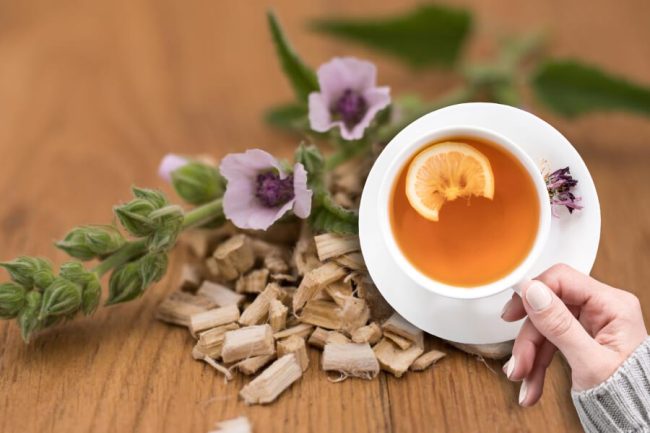When it comes to natural remedies, marshmallow root (Althaea officinalis) has been used for centuries for its remarkable health benefits. Whether you’re looking to improve your skin, soothe a cough, or support your digestive system, this plant has a wide range of uses.
Everything you need to know about the marshmallow plant, from its historical background to its modern applications is gathered here for you.
What is Marshmallow Root?
The marshmallow plant is a perennial herb native to Europe, Western Asia, and Northern Africa. It thrives in damp environments such as riverbanks, wetlands, and meadows.
Recognizable by its soft, velvety leaves and pale pink or white flowers, this plant has long been valued for its medicinal properties.
The roots, leaves, and flowers of the marshmallow plant are used in natural medicine, but the root contains the most potent therapeutic compounds. Marshmallow plant is rich in mucilage, a gel-like substance that gives it its soothing and healing properties.
Historical Uses of Marshmallow Root
The use of marshmallow plants dates back to ancient Egypt, where it was used as a remedy for sore throats and skin inflammations. The Greeks and Romans also prized the plant for its ability to treat wounds and aid digestion.
The marshmallow plant was used to clear heat from the body and promote lung health. Interestingly, the modern confection “marshmallow” got its name from the plant, as the original treat was made using marshmallow plant sap mixed with honey.
Health Benefits of Marshmallow Root
The marshmallow plant is renowned for its healing properties and has been widely studied for its ability to soothe inflammation, support respiratory health, and improve skin conditions. Below are some of its key health benefits:
Relieving Respiratory Issues
Marshmallow root has been traditionally used to treat coughs, bronchitis, and painful throats due to its mucilage content, which coats and soothes irritated tissues.
When taken as a tea or syrup, marshmallow plant can help reduce inflammation in the respiratory tract, easing dry coughs and promoting healing.
Soothing Skin Irritations
One of marshmallow root’s most notable benefits is its ability to calm and heal irritated skin. Its anti-inflammatory properties make it an effective treatment for conditions such as eczema, psoriasis, and dry skin.
When applied topically, marshmallow plants can hydrate the skin, reduce redness, and accelerate wound healing.
Healing Wounds
Due to its soothing and moisturizing qualities, marshmallow root has long been used to promote wound healing.
Its antibacterial and anti-inflammatory effects help prevent infections while encouraging the regeneration of healthy skin tissue. It can be applied as a salve or cream to cuts, burns, and insect bites.
Supporting Digestive Health
Marshmallow root has a calming effect on the digestive system, making it useful for treating gastrointestinal disorders such as acid reflux, gastritis, and irritable bowel syndrome (IBS).
The mucilage forms a protective layer on the stomach lining, reducing irritation and helping to ease symptoms of heartburn and ulcers.
Boosting Immune System
Rich in antioxidants, marshmallow root can also support the immune system by protecting the body against free radicals. Its anti-inflammatory and immune-boosting properties help the body recover more quickly from illness and prevent infections from taking hold.
How to Use Marshmallow Root
There are various ways to add marshmallow plants into your daily routine, depending on your health needs. Here are some popular methods:
Making Marshmallow Root Tea
Marshmallow plant tea is one of the most common ways to enjoy the herb’s benefits. To make it, simply steep a teaspoon of dried marshmallow plant in hot water for 10-15 minutes. The tea can soothe sore throats, aid digestion, and calm inflamed tissues.
Creating Marshmallow Root Infusions
An infusion is a stronger version of tea and is ideal for those needing extra relief. For a marshmallow plant infusion, allow the herb to steep for several hours or even overnight. This method draws out more mucilage, making the infusion highly effective for soothing irritated tissues.
Using Marshmallow Root Extracts
Marshmallow plant extracts are available in liquid form and can be added to water or taken directly. Extracts offer a more concentrated dose of the herb’s benefits, ideal for those needing quick relief from coughs, digestive issues, or skin irritations.
Applying Marshmallow Root Topically
For skin health, marshmallow plants can be applied directly to the skin in the form of creams, ointments, or salves. These products can be used to soothe dry skin, heal wounds, or reduce inflammation caused by eczema and other skin conditions.
Possible Side Effects and Cautions
While marshmallow plant is generally considered safe for most people, it’s important to be aware of potential side effects and precautions:
Common Side Effects
In rare cases, marshmallow plants may cause an upset stomach or dizziness. If you experience any discomfort after using the herb, discontinue use and consult a healthcare professional.
Potential Drug Interactions
Marshmallow root may interfere with the absorption of certain medications, particularly those taken orally. The mucilage can form a coating in the digestive tract that may prevent drugs from being fully absorbed. To avoid this, take marshmallow plant at least an hour before or after other medications.
Precautions and Warnings
Pregnant or breastfeeding women should consult a healthcare provider before using marshmallow plants, as there is limited research on their safety during pregnancy. Additionally, people with diabetes should use caution, as marshmallow plants may lower blood sugar levels.
Marshmallow Root in Everyday Life
Marshmallow plants can be a valuable addition to your daily routine, whether you’re adding it to your diet, skincare regimen, or herbal remedies.
Marshmallow Root Recipes
For a simple and healthy treat, try adding marshmallow plants to your favorite herbal teas or smoothies. Its mild flavor pairs well with other herbs, such as chamomile or peppermint.
Using Marshmallow Root in Skincare
Look for skincare products that contain marshmallow plant extract, or create your own DIY cleansers or moisturizers at home. The herb’s soothing properties make it an excellent ingredient for moisturizing lotions and healing balms.
Combining Marshmallow Root with Other Herbs
Marshmallow plant works well when combined with other herbs such as licorice root, slippery elm, or echinacea. These combinations can provide enhanced relief for sore throats, digestive discomfort, and skin irritations.
Conclusion
Marshmallow root is a versatile and effective natural remedy that offers numerous health benefits, from soothing respiratory issues to supporting digestive health and improving skin conditions.
Whether you’re new to herbal medicine or looking to expand your wellness routine, the marshmallow plant is a gentle yet powerful addition.
Always consult with a healthcare provider before adding any new herbs to your regimen, especially if you’re taking medications or have underlying health conditions.
FAQs
What does marshmallow root do for the body?
Marshmallow root soothes inflammation, supports respiratory and digestive health, and promotes skin healing.
Is it safe to take marshmallow root every day?
Yes, marshmallow root is generally safe for daily use, but consult a healthcare provider for prolonged or high-dosage use.
What is the most effective way to take marshmallow root?
Marshmallow root can be taken as tea, extract, or applied topically, depending on your health needs.
Does marshmallow root affect hormones?
There is no strong evidence that marshmallow root directly affects hormone levels, but consult your doctor if you have hormone-related concerns.







